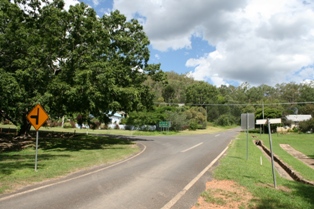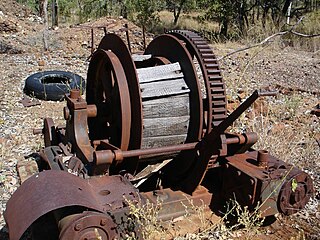
Hydraulic mining is a form of mining that uses high-pressure jets of water to dislodge rock material or move sediment. In the placer mining of gold or tin, the resulting water-sediment slurry is directed through sluice boxes to remove the gold. It is also used in mining kaolin and coal.

Ibis Dam is a dam built in 1906 on Ibis Creek that serves as a water supply for the town of Irvinebank, Far North Queensland, Australia. It has a spillway height of 55 feet (17 m). Established by John Moffat, a mining entrepreneur, its construction was supervised by Tom Brodie, a Scottish stonemason. It is located about 1 kilometre (0.62 mi) south of Irvinebank and has been providing water since its construction.

Irvinebank is a town and locality in the Shire of Mareeba, Queensland, Australia.

The Annan River is a river located in the Wet Tropics of Far North Queensland, Australia.

Nuggety Gully Water Race and Chinese Camp is a heritage-listed mining camp at Mareeba Mining District, Lakeland, Shire of Cook, Queensland, Australia. It was built from c. 1878 to c. 1886. It is also known as Greasy Bill Creek water race, Prospect Creek Stone Walls, and Star of Normanby Mine. It was added to the Queensland Heritage Register on 21 October 1992.

Stonyville Township, Water Race and Cemetery is a heritage-listed mining camp at Mareeba Mining District, Palmer, Shire of Cook, Queensland, Australia. It was built from the 1870s to c. 1900. It is also known as Stony Creek Township, Stonyville Water Race, and Stonyville Cemetery. It was added to the Queensland Heritage Register on 21 October 1992.

Collingwood Water Race is a heritage-listed aqueduct at Monkhouse Timber Reserve, Rossville, Shire of Cook, Queensland, Australia. It was built from 1902 to 1906. It is also known as Annan River Company Water Race. It was added to the Queensland Heritage Register on 13 April 2006.

Nettle Creek Tin Dredge is a heritage-listed dredge at Nettle Creek, Innot Hot Springs, Tablelands Region, Queensland, Australia. It was built in 1957. It is also known as Barrytown 2 Dredge, Barrytown Gold Dredge, and Battle Creek Tin Dredge. It was added to the Queensland Heritage Register on 22 September 1995.

Coolgarra Battery is a heritage-listed stamper battery at Coolgarra Station, Silver Valley, Tablelands Region, Queensland, Australia. It was built from 1896 to 1901. It is also known as Coolgarra Old Furnace. It was added to the Queensland Heritage Register on 25 August 2000.

Thermo Electric Ore Reduction Corporation Mill is a heritage-listed ruins of a mining building at Wolfram Road, Wolfram, Dimbulah, Shire of Mareeba, Queensland, Australia. It was built from 1906 to 1918. It was added to the Queensland Heritage Register on 7 April 2004.

Rocky Bluff Battery and Township is a heritage-listed former mining town at Watsonville, Shire of Mareeba, Queensland, Australia. It was built from 1902 to c. 1926. It is also known as Stannary Hills Mill. It was added to the Queensland Heritage Register on 13 December 2002.

Loudoun House is a heritage-listed detached house at 16 O'Callaghan Street, Irvinebank, in the Shire of Mareeba in Queensland, Australia. It was built c. 1883-1884. It is also known as Moffat's House. It was added to the Queensland Heritage Register on 21 October 1992. It is now operated as the Loudoun House Museum by the Irvinebank School of Arts & Progress Association.

Irvinebank State Treatment Works is a heritage-listed refinery off Jessie Street, Irvinebank, Shire of Mareeba, Queensland, Australia. It was built from 1883 to c. 1908. It is also known as Loudoun Mill. It was added to the Queensland Heritage Register on 21 October 1992.

Stannary Hills Tramways are a heritage-listed pair of tramways at Irvinebank, Shire of Mareeba, Queensland, Australia. It was built from 1901 to 1907. It was added to the Queensland Heritage Register on 25 February 2005.

Kingsborough Battery is a heritage-listed mining building off the former East Street, Kingsborough, Thornborough, Shire of Mareeba, Queensland, Australia. It was built from c. 1896 to 1990s. It was added to the Queensland Heritage Register on 21 October 1992.

Etheridge railway line is a heritage-listed railway line between Mount Surprise and Forsayth, both in the Shire of Etheridge, Queensland, Australia. It includes Mount Surprise railway station, Einasleigh railway station, Wirra Wirra railway station and Forsayth railway station. Etheridge railway line was added to the Queensland Heritage Register on 16 February 2009.

Ortona Mine and Battery is a heritage-listed mine at Forsayth-Agate Creek - Ortona (Iona) Station Road, Gilberton, Shire of Etheridge, Queensland, Australia. It was built from 1899 to 1908. It was added to the Queensland Heritage Register on 25 August 2000.

Irvinebank State School is a heritage-listed state school at High Street, Irvinebank, Shire of Mareeba, Queensland, Australia. It was designed by Robert and John Ferguson, Queensland Department of Public Works and built from 1889 to 1906 by Thomas Gordon and August Conrad Ferdinand Ohnesorgen. It was added to the Queensland Heritage Register on 1 May 2015.

The Adelong Falls Gold Workings is a heritage-listed former gold processing site and now picnic reserve at Adelong, Snowy Valleys Council, New South Wales, Australia. It was designed and built in 1860 by David Wilson and William Ritchie. It is also known as Adelong Falls Gold Workings/Reserve. The property is owned by the Snowy Valleys Council. It was added to the New South Wales State Heritage Register on 2 April 1999.

Gold Mining Water Race is a heritage-listed piece of mining infrastructure at Old Hargraves Road, Windeyer, Mid-Western Regional Council, New South Wales, Australia. It was built from 1855 to 1865 by Chinese miners, probably from Southern China. It was added to the New South Wales State Heritage Register on 22 December 2000.




















